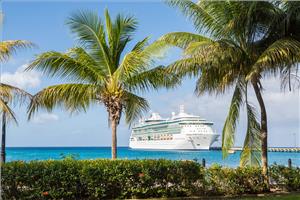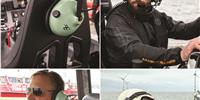Cruise lines are increasingly using technology to attract and entertain passengers. Whether it’s media content to help travelers wind down at the end of the day or smart tech meant to improve the overall cruise experience, cruise ships are becoming more high-tech.
Being out on the ocean creates some challenges to accessing technology, which has put cruise ships behind land-based attractions in terms of digital attractions. Recently, however, cruise lines have dedicated more resources to increasing the connectedness of their vessels. Here are five techy trends to look out for in the cruise industry.
1. Bluetooth Bracelets
One of the most innovative and headline-grabbing new features that cruise companies are rolling out involves high-tech wearables. These wristbands or pendants use Bluetooth or near field communications (NFC) to connect to onboard systems.
These devices provide conveniences to passengers such as the ability to unlock their door simply by walking up to it. It will also let staff know where passengers, helping them to determine when to clean rooms and deliver food to people no matter where they are.
Carnival will send the bracelets to passengers about a month before their trip to make the check-in process quicker.
The devices also provide a potential new source of income for the cruise line because travelers can use them to purchase food and other amenities and play games.
2. Faster Wi-Fi
Cruise ships have been notorious for slow internet in the past due to the challenges of creating a fast connection on an isolated boat out on the water. The industry is now beginning to rise above that reputation.
Cruise ships use satellites for internet access, which are inherently slower than the connection you probably use at home. Improvements in satellite technologies for cruise ships are now enabling faster connections. Whereas, in the past, going on a cruise meant disconnecting from the world, passengers can now watch videos, use social media and use video chat software while onboard.
This improved connectivity provides convinces to travelers, but it also has benefits for the cruise lines. Vacationers usually must pay to go online and the infrastructure enables other technology used by staff to function.
3. Smaller Communications Antennas
Along with improved internet speeds, cruise ship communications antennas are becoming more compact as well. In the past, ships needed large satellite and antennas that took up space and looked unsightly. New flat-panel antenna terminals are changing all that.
These new devices take up less space and can be placed on the sides of ships as opposed to on the deck, so the space they do take up wasn’t being used anyway. This creates more room for additional attractions such as a restaurant, bar or area for entertainment. This benefits passengers by giving them more room for activities without a decrease in internet speed.
4. Mobile Video Content
We used to only consume video content on the television, but today we watch it everywhere we go on our laptops, phones and tablets. We do this at home, but TV remains the only option when you’re on a cruise. Cruise companies are now working to change that.
The ability to use Netflix and other streaming options on cruise ships, as well as watch the available onboard movies, from mobile devices is beginning to show up across the industry. Ships’ enhanced Wi-Fi connections have made this possible.
Video still takes up a lot of bandwidth, however, so challenges remain. Cruise lines are working on the issue so that they can meet customer demand and create another additional revenue source. Soon, it might be entirely possible to catch a movie on your tablet while lounging on the deck.
5. Robotics
Some of the more eye-catching innovations onboard cruises involve robotics, which can interact with guests and help run the ship.
Royal Caribbean recently introduced what it calls the Bionic Bar. It doesn’t have human bartenders
but instead uses two robotic arms to mix drinks to order. Passengers use tablets located at the bar to tell the bots what drinks they want and can even create their own concoctions. They can watch the drinks get made, adding to the excitement of the experience.
In Tokyo in 2014,
Costa Cruises welcomed a new robotic member to their staff. The humanoid bot, named Pepper, entertains guests by playing games with them, dancing with them and asking them to take selfies together. The robot can also provide guests with information on the services available on the ship.
Pepper can even recognize human emotions and initiate interactions with guests as well as speak three languages — English, French and Italian.
Although technology is becoming more prevalent on cruise ships, it isn’t likely to take center stage any time soon. Instead, it will serve as a way to support the ship’s attractions and the natural wonders of the open ocean and seaside destinations — as well as the occasional escape from reality.










